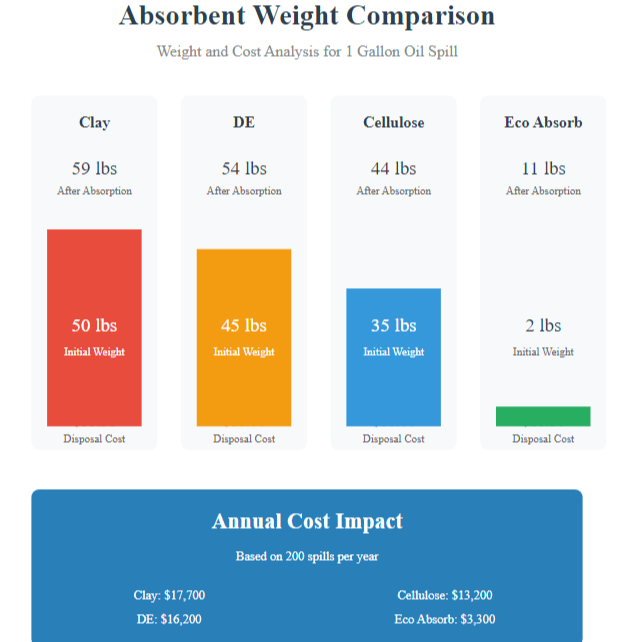
Revolutionary Absorbent That Saves Time, Money, & Reduces Risk
Discover why leading companies in automotive, oil & gas, chemical manufacturing, and more are switching to Eco Absorb for superior spill management.
The Industry's Most Effective Absorbent Solution
Eco Absorb is a premium perlite-based oil and chemical absorbent that outperforms traditional clay-based products in every metric that matters to your business.

Significant Cost Savings
Pair text with an image to focus on your chosen product, collection, or blog post. Add details on availability, style, or even provide a review.

Enhanced Workplace Safety
Pair text with an image to focus on your chosen product, collection, or blog post. Add details on availability, style, or even provide a review.

Increased Operational Efficiency
Pair text with an image to focus on your chosen product, collection, or blog post. Add details on availability, style, or even provide a review.
Add image of 'Us Vs Them' chart since no available section to create this
Don't just take our word for it
REQUEST FREE SAMPLE-
James R. - Operations Manager, Automotive Chain
"After switching from clay to Eco Absorb, we reduced our absorbent use by 50% and cut disposal costs by 60%. Total annual savings? Over $10,000 across our 5 locations. The lightweight bags also mean fewer injuries from heavy lifting."
-
Michael T. - Owner, Small Auto Shop
"We were skeptical at first about switching from clay to a perlite-based absorbent but after a month with Eco Absorb, we were amazed at how much we saved on product costs and disposal fees. Plus, our workers aren't coming home looking like dust bunnies anymore!"
-
Robert J. - Facility Manager, Oil & Gas Sector
Our drilling operation invested in Eco-Absorb's perlite-based product. The upfront cost was similar to clay, but we reduced our absorbent & disposal expenditure by 70% over two years, saving nearly $100,000. The ROI is undeniable.
Free Shipping + Volume Discounts
For a limited time, we're offering:
- Free shipping on full pallet orders ($1250/pallet)
- 5% discount on each additional pallet ordered
- Net 40 payment terms available for qualified businesses
Not ready for a pallet? No problem! Request a free sample below to experience Eco Absorb's superior performance firsthand.
Frequently Asked Questions
What makes Eco Absorb different than other absorbents?
Eco Absorb is made from perlite, a naturally occurring volcanic glass, rather than clay or diatomaceous earth. This makes it substantially lighter (7lbs vs 50+lbs), more absorbent (up to 4X capacity) completely dust-free, and environmentally friendly with no crystalline silica. The result is faster cleanup, lower disposal costs, and reduced workplace hazards.
What types of spills can Eco Absorb handle?
Eco Absorb is incredibly versatile and can effectively absorb oils, fuels, coolants, solvents, water-based fluids, and most other industrial liquids. It's ideal for use in automotive shops, manufacturing facilities, warehouses, oil & gas operations, and anywhere else where spills occur.
How much can I save by switching to Eco Absorb?
While savings vary by industry and usage, our customers typically report 50%-70% reductions in total absorbent-related costs. The savings come from multiple sources; less product needed per spill, lower shipping costs, dramatically reduced disposal costs due to lighter weight, and indirect savings from improved safety (fewer accidents) and efficiency (faster cleanup).
How many bags come on a pallet, and how much area does it cover?
A standard pallet contains 55 bags of Eco Absorb with each bag containing 2 cubic foot of material. Each bag can absorb approximately 4-5 gallons of oil or other fluids, making a full pallet capable of handling 220-275 gallons of spilled material. Coverage area depends on spill depth, but typically one bag can cover about 100-150 square feet of light spills.
Is Eco Absorb compliant with environmental regulations?
Yes, Eco Absorb meets and exceeds EPA and OSHA standards. It contains no crystalline silica or other hazardous materials, making it safer for both workers and the environment. While disposal requirements depend on what has been absorbed, the product itself does not add any hazardous components to the waste stream.
